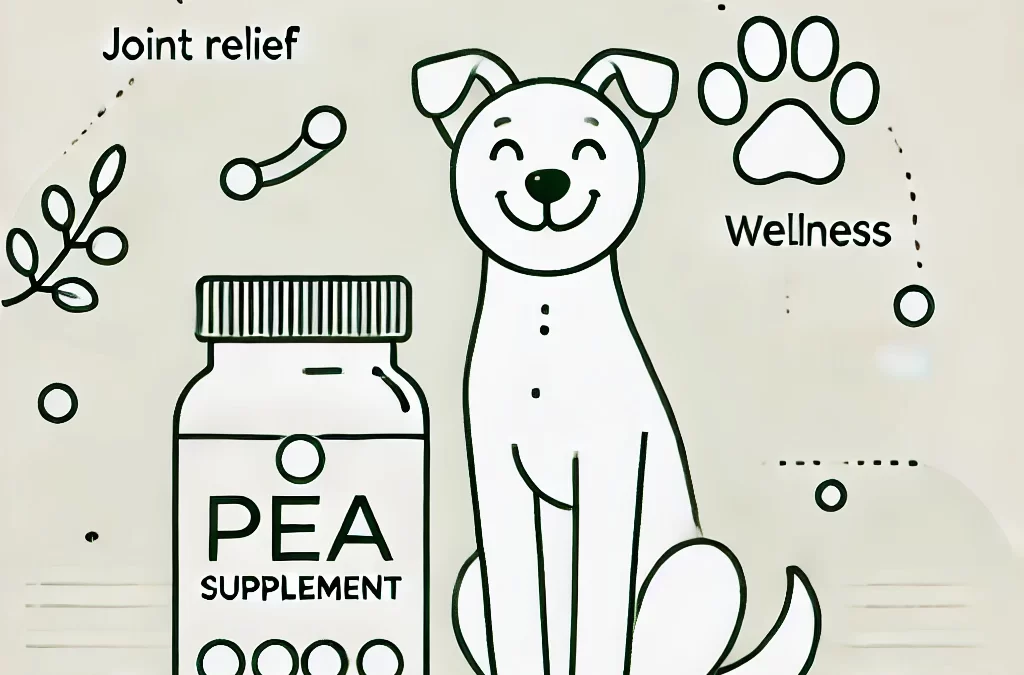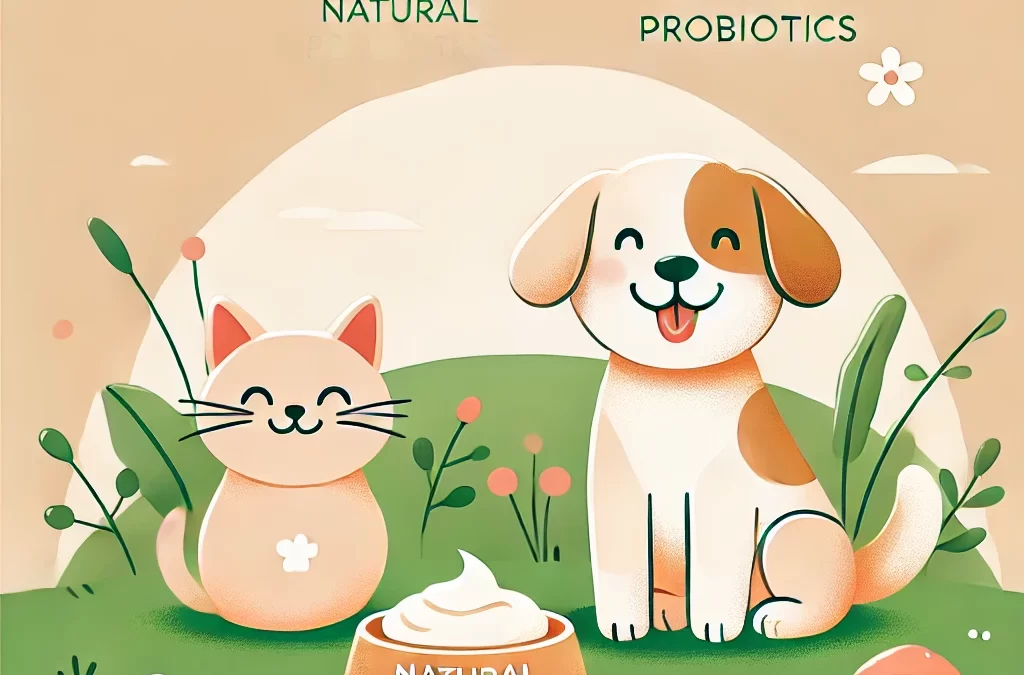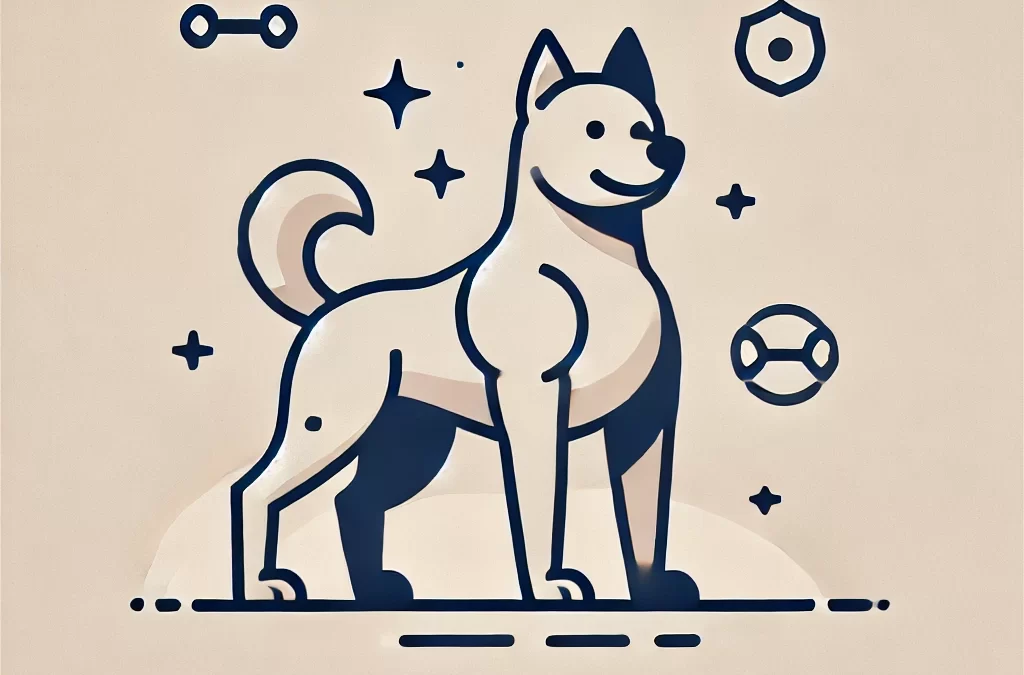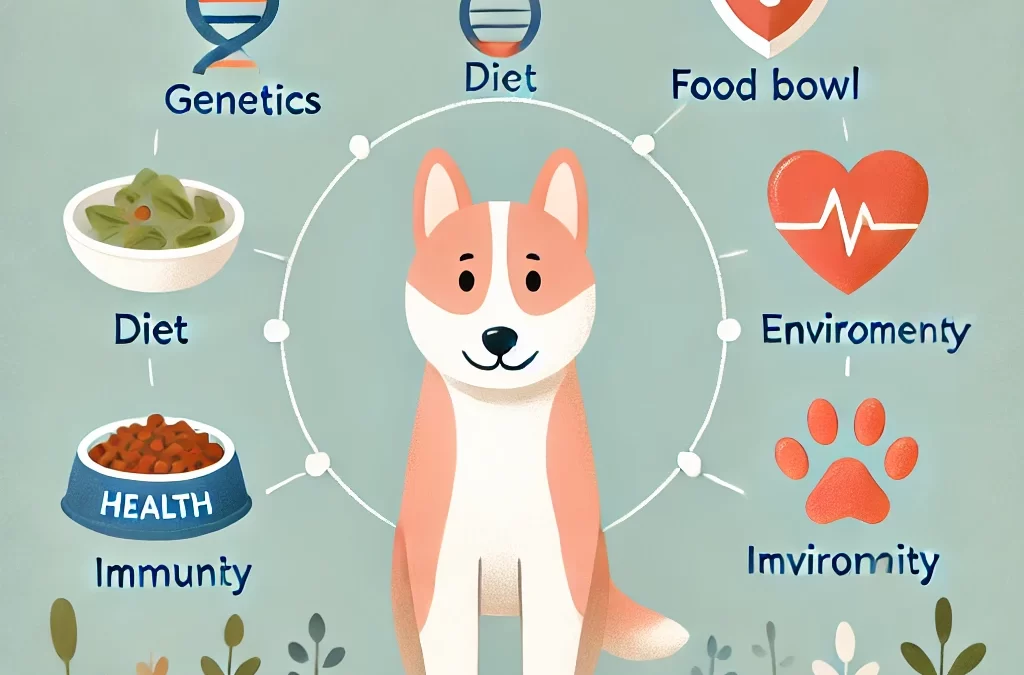
par TCMVET | 13 novembre 2024 | Alimentation et santé
Le palmitoyléthanolamide, ou PEA, gagne en popularité dans le monde des soins canins en raison de ses propriétés naturelles anti-inflammatoires et analgésiques. Découvert à l’origine comme un amide d’acide gras produit par le corps, le PEA est un composé de type endocannabinoïde présent dans divers tissus, notamment le cerveau et le système immunitaire. Ce composé unique, présent dans des aliments comme les œufs et le soja, a montré des avantages potentiels dans la gestion de la douleur et la réduction de l’inflammation chez les humains et les animaux. Mais qu’est-ce que cela signifie pour nos compagnons canins ?
Qu’est-ce que le PEA et pourquoi est-il utile pour les chiens ?
Le PEA est naturellement produit dans le corps des humains et des chiens en réponse à l'inflammation et à la douleur. En tant que composé endogène, le PEA agit avec le système endocannabinoïde pour aider à moduler l'inflammation et la perception de la douleur sans effets psychoactifs. Cela en fait une alternative plus sûre pour les animaux de compagnie par rapport aux produits pharmaceutiques traditionnels, en particulier pour une utilisation à long terme.
Principaux avantages du PEA pour les chiens :
- Soulagement de la douleur: Le PEA interagit avec les récepteurs du système nerveux, offrant un moyen naturel de réduire l’inconfort.
- Propriétés anti-inflammatoires : Il agit sur la réponse immunitaire du corps pour diminuer l’inflammation, ce qui peut être bénéfique pour les chiens souffrant d’arthrite, de dermatite et d’autres affections inflammatoires.
- Improved Quality of Life: En soulageant la douleur et l’inflammation, le PEA peut améliorer la mobilité, les niveaux d’énergie et le bien-être général.
Comment fonctionne le PEA ?
Contrairement à d’autres analgésiques, le PEA ne bloque pas directement les signaux de douleur. Il agit plutôt sur ce que l’on appelle « l’effet d’entourage », en améliorant les processus naturels qui régulent la douleur et l’inflammation. Voici un aperçu simplifié de son fonctionnement :
- Interaction avec les récepteurs cannabinoïdes:Le PEA interagit indirectement avec les récepteurs cannabinoïdes (récepteurs CB2) du système immunitaire, favorisant une réponse immunitaire équilibrée.
- Inhibition des enzymes inflammatoires:Il inhibe les enzymes qui alimentent l’inflammation, permettant aux processus de guérison naturels du corps de fonctionner plus efficacement.
- Stabilisation des mastocytes:Le PEA stabilise les mastocytes, qui sont des cellules immunitaires qui libèrent des histamines en réponse à une blessure ou à une inflammation, réduisant ainsi l’inconfort lié à l’inflammation.
Quelles conditions le PEA peut-il aider à gérer chez les chiens ?
Le PEA peut être bénéfique pour les chiens souffrant de diverses maladies chroniques :
- Arthrite:Ses effets anti-inflammatoires peuvent aider les chiens souffrant d’inflammation et de raideur articulaires.
- Skin Conditions:Les chiens souffrant de dermatite chronique peuvent ressentir un soulagement des démangeaisons et des irritations.
- Affections neurologiques:Certaines recherches suggèrent que le PEA peut aider les chiens souffrant de douleurs nerveuses en calmant les cellules nerveuses hyperactives.
- Récupération post-opératoire:Les propriétés analgésiques du PEA peuvent favoriser une récupération plus rapide et une gestion de la douleur après une intervention chirurgicale.
Utilisation du PEA en toute sécurité : dosage et précautions
Le PEA est généralement bien toléré, mais il est essentiel de suivre une approche sûre :
- Consulter un vétérinaire:Parlez toujours à un vétérinaire avant d'introduire le PEA dans la routine de votre chien, surtout s'il prend d'autres médicaments.
- Commencez lentement: Introduisez le PEA à des doses plus faibles et surveillez toute réaction. Le PEA est généralement disponible sous forme de comprimés, de poudre ou de comprimés à croquer, avec des recommandations de dosage basées sur le poids corporel.
- Observer et ajuster:Surveillez la réponse de votre chien, en ajustant la posologie si nécessaire sous surveillance vétérinaire.
Choisir le bon complément PEA pour votre chien
Tous les compléments PEA ne sont pas identiques. Lorsque vous choisissez un produit PEA, recherchez :
- Pureté et qualité:Choisissez des suppléments testés pour leur pureté et exempts de contaminants.
- Forme micronisée:Cette forme de PEA est plus biodisponible, ce qui signifie qu'elle est absorbée plus efficacement dans le système de votre chien.
- Produits spécifiques pour chiens:Certaines marques conçoivent du PEA spécifiquement pour les animaux de compagnie, garantissant le dosage et la formulation corrects.
Réflexions finales : l’avenir du PEA dans les soins aux animaux de compagnie
Alors que de plus en plus de propriétaires d'animaux recherchent des options naturelles pour améliorer la vie de leurs chiens, le PEA se distingue comme un ajout prometteur. Son approche multidimensionnelle du soulagement de la douleur et de la gestion de l'inflammation peut bénéficier aux animaux vieillissants, à ceux qui souffrent de maladies chroniques et à tout chien ayant besoin d'un soutien sûr et doux pour son bien-être.
Grâce à des recherches de plus en plus poussées et à des formulations de plus en plus spécifiques aux animaux de compagnie, le PEA pourrait bientôt devenir un élément essentiel des soins holistiques pour animaux de compagnie. Ses mécanismes uniques et sa sécurité éprouvée en font une option viable et innovante pour soutenir le confort et la vitalité des chiens sans les effets secondaires des médicaments conventionnels.

par TCMVET | 13 novembre 2024 | Alimentation et santé
Tout comme les humains, les animaux de compagnie peuvent grandement bénéficier des probiotiques, ces « bonnes bactéries » qui favorisent la santé intestinale, l’immunité et le bien-être général. Si les probiotiques commerciaux sont populaires, les sources naturelles de probiotiques émergent comme une approche efficace et holistique. Cet article explique ce que sont les probiotiques naturels, où les trouver et comment ils peuvent améliorer naturellement la santé de votre animal.
1. Que sont les probiotiques naturels pour animaux de compagnie ?
- Définition:Les probiotiques naturels sont des bactéries bénéfiques vivantes présentes dans les aliments, les herbes et les plantes naturellement fermentés.
- Comment ils fonctionnent:Ces micro-organismes aident à équilibrer le microbiome intestinal, à améliorer la digestion, à renforcer la réponse immunitaire et peuvent même avoir un impact positif sur l’humeur.
- Différence avec les probiotiques commerciaux:Les probiotiques naturels proviennent d’aliments entiers et sont moins transformés, offrant une solution plus proche de la nature.
2. Avantages des probiotiques naturels pour les animaux de compagnie :
- Une meilleure digestion:Les probiotiques peuvent aider à décomposer les aliments, à absorber les nutriments et à réduire les problèmes digestifs comme les gaz ou la diarrhée.
- Une immunité renforcée:Un microbiome intestinal équilibré renforce le système immunitaire, aidant les animaux de compagnie à combattre plus efficacement les infections.
- Soulagement des allergies:La consommation régulière de probiotiques peut soulager les allergies cutanées en réduisant l’inflammation dans l’intestin, où naissent de nombreuses réponses immunitaires.
- Humeur et comportement:Les recherches montrent un lien entre la santé intestinale et l’humeur, suggérant que les probiotiques peuvent avoir un effet calmant sur les animaux de compagnie.
3. Sources de probiotiques naturels pour animaux de compagnie :
- Yaourt et Kéfir:Le yaourt nature non sucré et le kéfir sont riches en probiotiques comme Lactobacillus acidophilus et Bifidobactérie. Ceux-ci peuvent favoriser la santé digestive s’ils sont administrés en petites quantités sans danger.
- Légumes fermentés:De petites quantités de légumes fermentés comme la choucroute (non salée) peuvent offrir des probiotiques, mais ceux-ci doivent être introduits avec prudence.
- Vinaigre de cidre de pomme:Le vinaigre de cidre de pomme brut contient des enzymes et des bactéries bénéfiques, mais il doit être dilué avant utilisation pour éviter les troubles digestifs.
- Herbes et organismes vivant dans le sol:Certaines herbes comme la racine de pissenlit et la racine de chicorée contiennent des prébiotiques, qui nourrissent les bactéries bénéfiques. De plus, les probiotiques d'origine terrestre présents dans les sols biologiques sans danger pour les animaux peuvent naturellement favoriser la santé intestinale.
4. Comment introduire des probiotiques naturels dans l'alimentation de votre animal
- Commencer petit:Introduisez de petites quantités et surveillez tout trouble digestif ou réaction.
- Observer et ajuster:Si votre animal semble en bénéficier, augmentez progressivement la fréquence ou la quantité selon les conseils d'un vétérinaire.
- La cohérence est la clé:Des doses régulières et constantes de probiotiques naturels ont tendance à donner les meilleurs résultats, alors trouvez une méthode adaptée à la routine quotidienne de votre animal.
5. Quand envisager les probiotiques naturels plutôt que les compléments alimentaires
- Pour les animaux sensibles:Les animaux domestiques qui ne tolèrent pas bien les suppléments probiotiques commerciaux pourraient mieux réagir aux sources naturelles.
- Traitement post-antibiotique:Après une série d’antibiotiques, les probiotiques naturels peuvent aider à restaurer le microbiome intestinal.
- Entretien quotidien de la santé:Si vous recherchez une approche préventive, les probiotiques naturels peuvent être une option douce et efficace pour la santé quotidienne.
6. Conseils de sécurité et éléments à surveiller
- Évitez les additifs: Optez pour des sources probiotiques simples, sans saveur et sans sucre, car les additifs comme le sucre et les arômes artificiels peuvent nuire aux animaux de compagnie.
- Consult Your Vet:Vérifiez toujours auprès de votre vétérinaire, surtout si votre animal souffre de problèmes de santé sous-jacents ou d’allergies.
- Surveiller les effets secondaires:Dans de rares cas, les animaux domestiques peuvent souffrir d’une légère diarrhée ou de ballonnements pendant que leur système s’adapte aux nouveaux probiotiques.
Conclusion :
Les probiotiques naturels offrent une solution holistique pour améliorer la santé de votre animal de compagnie, en favorisant la digestion, l'immunité et même l'humeur. En introduisant des sources sûres et naturelles de probiotiques, vous offrez un chemin plus naturel vers le bien-être. Avec de la patience et de la cohérence, ces aides naturelles peuvent devenir un élément essentiel de la routine de votre animal pour une vie plus heureuse et plus saine.

par TCMVET | 13 novembre 2024 | Cancer et tumeurs du chien
Les amas graisseux, ou lipomes, sont l'une des excroissances non cancéreuses les plus courantes chez les chiens, en particulier lorsqu'ils vieillissent. Les propriétaires d'animaux de compagnie ressentent souvent un sentiment d'inquiétude lorsqu'ils découvrent ces amas, mais la plupart des lipomes sont bénins. Dans cet article, nous allons découvrir à quoi ressemblent ces amas graisseux, comment les distinguer des autres excroissances et vous donner des conseils sur le moment opportun pour consulter un vétérinaire.
1. Que sont les amas graisseux ?
- Définition des lipomes:Les lipomes sont des dépôts graisseux mous qui se forment sous la peau, généralement chez les chiens âgés ou en surpoids.
- Emplacements communs:On le trouve généralement sur le torse, les aisselles et les membres, mais peut apparaître à divers endroits.
- Cause:Bien que les causes exactes ne soient pas entièrement connues, elles peuvent être liées à l’âge, à la race, à la génétique et au poids.
2. La sensation des grumeaux graisseux :
- Doux et mobile:Les lipomes sont généralement mous et légèrement spongieux, comme un morceau de pâte sous la peau. Ils sont faciles à déplacer avec une légère poussée, ce qui les différencie souvent des excroissances plus dures et moins mobiles.
- Pas douloureux:Contrairement aux kystes ou aux abcès, les lipomes ne sont pas douloureux, sauf s’ils appuient sur un nerf ou une articulation.
- Texture homogène:Les lipomes ont généralement la même sensation au toucher, avec une texture homogène et pâteuse.
3. Différences entre les lipomes et les autres types de tumeurs :
- Cysts:Souvent plus fermes, les kystes peuvent être remplis de liquide et parfois présenter un point central, contrairement à l'uniformité d'un lipome.
- Abcès:Ces douleurs sont généralement douloureuses et chaudes au toucher, souvent accompagnées de rougeurs.
- Croissances cancéreuses:Les tumeurs malignes peuvent être plus dures au toucher, sont souvent fixées en place et peuvent croître rapidement ou de manière irrégulière. Les tumeurs peuvent être de forme irrégulière ou fermes au toucher.
- Fibromes:Ces tumeurs bénignes sont plus fermes que les lipomes et moins mobiles, mais sont généralement inoffensives.
4. Quand faut-il s’inquiéter ?
- Taux de croissance:Si une bosse grandit rapidement, change de forme ou devient douloureuse, il est préférable de consulter immédiatement un vétérinaire.
- Problèmes d'emplacement:Les bosses près des articulations ou dans les zones qui affectent la mobilité peuvent nécessiter leur retrait ou leur surveillance.
- Plusieurs grumeaux:Les lipomes multiples sont fréquents chez certaines races, mais si de nouvelles bosses apparaissent rapidement, envisagez un contrôle vétérinaire.
5. Diagnostic des lipomes :
- Examen vétérinaire:Un vétérinaire peut confirmer si une masse est un lipome par palpation.
- Aspiration à l'aiguille fine (FNA):Pour un diagnostic plus définitif, la FNA peut recueillir des cellules de la masse pour analyse, permettant ainsi de déterminer si la masse est bénigne ou nécessite une enquête plus approfondie.
6. Faut-il retirer les lipomes ?
- Quand une intervention chirurgicale est nécessaire:En général, les lipomes sont laissés tranquilles à moins qu’ils ne provoquent une gêne, ne restreignent les mouvements ou ne se développent de manière excessive.
- Options minimalement invasives:De nouvelles méthodes, comme la liposuccion ou les injections de stéroïdes, peuvent aider à réduire les lipomes dans certains cas.
7. Conseils de prévention et de santé pour réduire les lipomes :
- Maintenir un poids santé:L’obésité est un facteur de risque connu des lipomes.
- Contrôles réguliers:Des visites régulières chez le vétérinaire permettent une détection précoce et une surveillance de toute nouvelle croissance.
- Alimentation équilibrée et exercice physique:Une alimentation équilibrée et un exercice régulier peuvent aider à prévenir l’obésité, ce qui peut réduire le risque de lipomes.
Conclusion : Bien que les amas graisseux chez les chiens puissent être inquiétants, ils sont souvent inoffensifs et faciles à gérer. En comprenant la sensation, les causes et les symptômes des lipomes, les propriétaires de chiens peuvent prendre des décisions éclairées concernant la santé de leur animal. Si vous n'êtes pas sûr d'avoir une grosseur sur votre chien, demandez toujours l'avis d'un professionnel pour avoir l'esprit tranquille.

par TCMVET | 12 novembre 2024 | Cancer et tumeurs du chien
Pour les propriétaires d'animaux qui cherchent à aider leur chien à développer sa masse musculaire, à améliorer sa force ou à se remettre d'une blessure, l'idée de suppléments de renforcement musculaire peut sembler intrigante. Bien qu'ils ne soient pas la norme pour tous les chiens, ces suppléments peuvent être bénéfiques pour certaines races, les chiens à haute énergie, les chiens de travail et même ceux en convalescence. Nous explorerons ici les avantages des suppléments de renforcement musculaire pour chiens, les ingrédients clés à rechercher et des conseils pour choisir des produits sûrs et efficaces.
1. Pourquoi les muscles sont importants pour les chiens
Un système musculaire sain est essentiel pour tous les chiens, pas seulement pour les chiens actifs ou sportifs. Les muscles aident à soutenir les articulations, à améliorer l'endurance et à maintenir la mobilité globale. Pour les chiens qui pratiquent l'agilité, la chasse ou d'autres activités de haute intensité, des muscles forts peuvent aider à prévenir les blessures et à améliorer les performances. De plus, les chiens plus âgés, ceux qui se remettent d'une opération chirurgicale et les chiens souffrant de certaines maladies comme l'arthrite peuvent bénéficier d'un soutien musculaire pour maintenir leur force et réduire l'inconfort.
2. Qui devrait envisager des suppléments de renforcement musculaire ?
Les suppléments de renforcement musculaire ne sont pas nécessaires pour tous les chiens, mais ils peuvent être bénéfiques pour :
- Races actives : Les races comme les Border Collies, les bergers allemands et les labradors sont naturellement très énergiques et s'épanouissent grâce à une routine d'exercice structurée.
- Chiens de travail : Les chiens policiers, militaires et de service nécessitent souvent des capacités physiques accrues.
- Chiens âgés : Les chiens vieillissants peuvent perdre de la masse musculaire au fil du temps. Les compléments alimentaires peuvent aider à maintenir le tonus musculaire, ce qui favorise la santé des articulations.
- Chiens en convalescence : Les chiens qui se remettent d’une intervention chirurgicale ou d’une blessure peuvent avoir besoin d’un soutien supplémentaire pour retrouver force et mobilité.
3. Ingrédients clés à rechercher
Tous les compléments alimentaires pour la musculation ne sont pas égaux, il est donc important de comprendre les avantages des ingrédients pour choisir un produit de qualité. Voici les principaux ingrédients qui peuvent favoriser la santé musculaire :
- Acides aminés : Les acides aminés comme la L-carnitine et la L-glutamine, éléments constitutifs des protéines, contribuent au développement et à la récupération musculaire. Ils sont essentiels pour que les chiens développent ou conservent une masse musculaire maigre.
- Créatine : Bien que communément associée au culturisme humain, la créatine est un composé naturel qui peut aider les chiens à améliorer leurs performances musculaires. Elle est particulièrement bénéfique pour les courtes périodes d'énergie, comme le sprint ou l'entraînement d'agilité.
- Les acides gras omega-3: Ces graisses saines sont connues pour réduire l’inflammation, ce qui peut favoriser la récupération après l’exercice. Les oméga-3 peuvent également favoriser la santé des articulations, ce qui en fait un bon complément à un supplément axé sur les muscles.
- Sources de protéines : Les sources de protéines de haute qualité comme le poulet, le poisson ou le bœuf fournissent des nutriments essentiels à la croissance et à la réparation musculaires. Certains compléments de renforcement musculaire contiennent de la poudre de protéines déshydratées.
- Composés de soutien articulaire : Des ingrédients comme la glucosamine et la chondroïtine ne contribuent pas directement au développement musculaire, mais ils favorisent la santé des articulations, ce qui est essentiel pour les chiens actifs qui souhaitent développer et maintenir leurs muscles.
4. Choisir le bon complément pour développer les muscles
Lorsque vous choisissez un supplément, tenez compte de ces conseils pour vous assurer de fournir le produit le plus sûr et le plus efficace à votre chien :
- Choisissez des produits spécifiques aux chiens : Certains compléments alimentaires destinés à la musculation humaine peuvent être nocifs pour les chiens. Recherchez des produits spécialement formulés pour la physiologie canine.
- Vérifiez les ingrédients de haute qualité : Moins il y a d'additifs, d'arômes artificiels ou de conservateurs, mieux c'est. Un bon complément doit être riche en ingrédients entiers.
- Parlez à votre vétérinaire : Avant de commencer tout supplément, consultez votre vétérinaire, surtout si votre chien souffre de problèmes de santé préexistants.
- Commencez lentement : Introduisez progressivement tout nouveau supplément pour observer la réaction de votre chien et évitez de lui donner plus que la dose recommandée.
5. Complémentation versus alimentation naturelle
Les compléments alimentaires peuvent être un moyen pratique de renforcer la santé musculaire de votre chien, mais une alimentation équilibrée est essentielle. Les régimes riches en protéines, notamment les viandes maigres, les œufs et certains poissons, peuvent naturellement favoriser la santé musculaire. Les compléments alimentaires sont plus efficaces lorsqu'ils sont associés à une bonne nutrition et à une routine d'exercice appropriée.
6. Développer ses muscles grâce à l'exercice et à l'entraînement
Les compléments alimentaires seuls ne suffisent pas à développer les muscles. Une routine d'exercice bien structurée est essentielle. Concentrez-vous sur des activités qui sollicitent l'ensemble du corps, telles que :
- Promenades ou randonnées lestées : Attacher un sac à dos léger peut fournir une résistance douce aux chiens en bonne santé.
- Entraînement d'agilité : Encourage la flexibilité et développe la force tout en gardant votre chien stimulé mentalement.
- Natation: Exercice à faible impact, la natation est excellente pour la croissance musculaire et la santé des articulations.
Conclusion : Construire un chien plus fort et en meilleure santé
Les compléments alimentaires pour la musculation peuvent être un complément précieux pour les chiens qui ont besoin d'un regain de force, mais ils fonctionnent mieux lorsqu'ils sont associés à une alimentation équilibrée et à de l'exercice. En choisissant soigneusement des compléments de haute qualité et en tenant votre vétérinaire informé, vous pouvez soutenir la santé musculaire de votre chien, en veillant à ce qu'il reste actif, fort et prêt pour les aventures de la vie.

par TCMVET | 12 novembre 2024 | Cancer et tumeurs du chien
Le cancer est l'une des maladies les plus dangereuses pour les humains et les animaux de compagnie, et il est particulièrement déchirant lorsqu'il touche nos chers chiens. Mais comprendre pourquoi et comment le cancer se développe chez les chiens peut éclairer la prévention et donner des indications sur la détection précoce. Bien qu'il n'existe aucun moyen infaillible de prévenir le cancer, explorons les principaux facteurs contributifs, les recherches émergentes et les moyens de contribuer à réduire les risques.
1. Génétique : l'influence de la race et de l'histoire familiale
Certaines races ont une plus grande prédisposition au cancer. Par exemple, les races comme les Golden Retrievers, les Boxers et les Rottweilers sont génétiquement prédisposées à développer certains cancers. Les recherches suggèrent que les mutations génétiques héréditaires jouent un rôle important dans ces tendances. Une étude publiée dans Génétique et épidémiologie canine Des études ont révélé que certaines races partagent des traits génétiques qui les rendent plus sensibles aux tumeurs. Par conséquent, la lignée d'un chien peut augmenter son risque, ce qui signifie que les propriétaires d'animaux de compagnie de certaines races doivent être particulièrement vigilants et effectuer des contrôles vétérinaires réguliers.
2. Facteurs environnementaux : substances cancérigènes et toxines du quotidien
Les chiens sont exposés aux toxines environnementales, tout comme les humains. Les coupables les plus courants sont la fumée secondaire, certains produits de nettoyage, les pesticides et la pollution. Les chiens, en contact étroit avec les sols et les surfaces extérieures, peuvent facilement ingérer ou inhaler des substances nocives, introduisant sans le savoir des toxines dans leur corps. De plus en plus de preuves montrent également une corrélation directe entre l'exposition à des substances cancérigènes spécifiques et l'augmentation des risques de cancer chez les chiens.
Informations exploitables : Pour minimiser l’exposition, pensez à choisir des produits de nettoyage naturels, à éviter de fumer à proximité des animaux domestiques et à vous assurer que les aires de jeu de votre chien sont exemptes de pesticides.
3. Régime alimentaire : le rôle de la nutrition dans la prévention du cancer
L’alimentation d’un chien peut avoir des effets considérables sur sa santé, en influençant son système immunitaire et sa santé cellulaire. Une alimentation de mauvaise qualité, riche en agents de remplissage et en additifs artificiels, peut contribuer aux mutations cellulaires et à l’inflammation, pouvant conduire au cancer. En revanche, une alimentation équilibrée, riche en antioxydants, en acides gras oméga et en protéines naturelles, peut favoriser la réparation cellulaire et les défenses immunitaires.
Recommandation alimentaire : Envisagez de passer à des repas de qualité, biologiques ou même faits maison, adaptés aux besoins nutritionnels de votre chien. Consultez toujours un vétérinaire pour obtenir des conseils sur le meilleur régime alimentaire.
4. Influences hormonales et santé reproductive
Les hormones sont de puissants messagers chimiques dans le corps et peuvent influencer la croissance tumorale. Des études ont montré que la stérilisation à l’âge approprié peut réduire le risque de certains cancers, comme le cancer du sein ou des testicules. Cependant, le moment de ces procédures est essentiel, car une stérilisation précoce a été associée à un risque accru d’autres cancers, comme l’ostéosarcome.
Décision équilibrée : Discutez avec votre vétérinaire du meilleur moment pour stériliser votre chien, car le moment peut varier en fonction de la race et de l’état de santé de chaque individu.
5. Infections et virus
Certaines infections et virus sont connus pour être cancérigènes. Chez les chiens, des virus comme le papillomavirus canin peuvent provoquer des verrues qui peuvent se transformer en tumeurs malignes dans de rares cas. De plus, les infections qui provoquent une inflammation chronique peuvent entraîner des changements et des mutations cellulaires au fil du temps, pouvant conduire au cancer.
6. Le vieillissement : un facteur inévitable
L'âge est l'un des facteurs de risque les plus importants du cancer chez le chien. Grâce aux progrès des soins vétérinaires, les chiens vivent plus longtemps et le risque de cancer augmente avec l'âge. À mesure que les cellules d'un chien vieillissent, les mécanismes de réparation des dommages à l'ADN peuvent devenir moins efficaces, ce qui facilite l'apparition de mutations cancéreuses.
Mesures préventives et changements de style de vie pour une vie plus saine
Même si tous les cas de cancer ne sont pas évitables, certains changements de style de vie peuvent contribuer à réduire les risques. Voici quelques mesures préventives qui pourraient favoriser la santé à long terme :
- Routine Veterinary Care: Des examens réguliers permettent de détecter toute croissance anormale ou tout signe avant-coureur.
- Choix alimentaires sains : Choisissez des aliments riches en nutriments essentiels, sans additifs ni agents de remplissage artificiels.
- Maintenir un environnement propre : Utilisez des produits non toxiques et évitez d’exposer votre chien à des produits chimiques nocifs.
- Faites de l'exercice régulièrement : Garder votre chien actif favorise un système immunitaire robuste, essentiel pour lutter contre les maladies.
Conclusion : la connaissance comme meilleure défense
Comprendre les facteurs qui contribuent au cancer chez les chiens peut nous aider à faire des choix éclairés et, dans la mesure du possible, à réduire le risque. Bien que la génétique et l’âge soient hors de notre contrôle, nous pouvons prendre des mesures pour garantir à nos chiens une vie plus saine et plus longue. En restant vigilants, en donnant la priorité à des soins de qualité et en favorisant un environnement sans toxines, nous pouvons donner à nos chiens les meilleures chances de vivre sans cancer.





